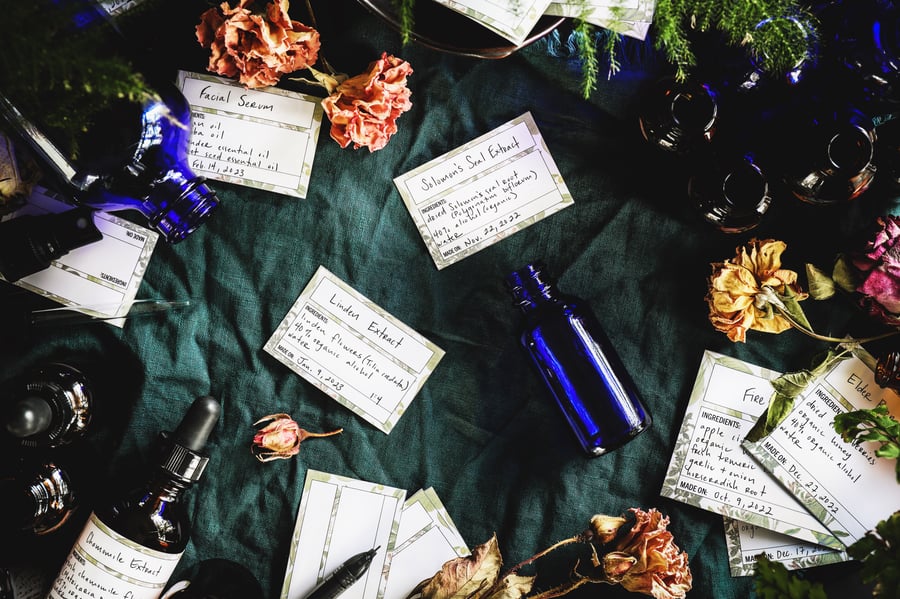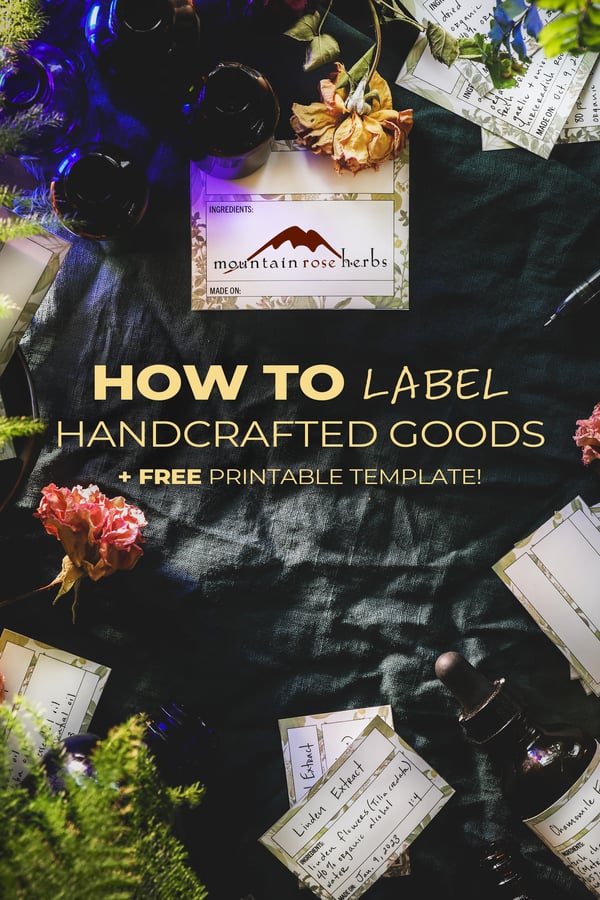At Mountain Rose Herbs, we talk a lot about the importance of labeling homemade herbal remedies, essential oil blends, and the other handcrafted goods that we put in our apothecaries and gift to our loved ones. Proper labeling makes at-a-glance identification easy, ensures we have appropriate dosage information, and helps us keep track of the age of our formulations. On a purely practical level, it also makes it easier to avoid having a cupboard full of unused mystery bottles. We may think we will never forget what we put in that tincture, tea, or aromatherapy blend, or we may have the best intentions of making a label and writing helpful notes later. But then life happens, and we put it off. So there we are weeks or months after, realizing we can no longer remember the exact proportions or even which tincture is which. We have all been there and done that.
It is tempting to rely on our sense of smell or taste to identify different items in our apothecaries. Smelling and/or tasting an herb is helpful with culinary and other edible herbs and spices to determine if one is past its prime. But many herbal formulations—and tinctures in particular—are often tricky to tell apart by sniffing or tasting. Also, some herbs like arnica and comfrey are not safe for internal use, so ingesting them in any form to identify what they are can be dangerous.
So, promptly labeling our homemade herbal products is an important step that we need to include every time we put herbs in a jar to infuse with a menstruum, and again when we bottle the final product. We also need to label any unique aromatherapy blends, teas, herb and spice mixes, etc. It sounds time-consuming, but having a pre-made label or labeling materials readily available to you makes the process much more straightforward.
Where to Get Labels
The creative/artistic sorts out there may want to make personalized label designs, which you can print on waterproof sticker paper. Alternatively, lovely pre-designed labels are often available at local craft stores. You can also search online; there are a lot of working artists and small businesses that sell pre-made and custom labels.
To make it easy to have lovely labels on hand when you need them, you can also sign up for our FREE LABEL TEMPLATE to print at home! We designed this beauty with the home herbalist in mind.
In the end, however, labels don’t need to be beautiful to be effective. Masking tape, painter's tape, and plain sticky labels all work well and are relatively inexpensive, easy to remove, and readily available in office supplies or hardware stores. However, a label is not going to do any good if it gets dripped on and disintegrates or the ink smears into an unreadable blur, so also having some clear, waterproof tape to cover these materials can save you a headache later (but this tape is harder to get off a jar, so you’ll want to use it strategically). You can also purchase waterproof labels and markers, and if you can spend a little more money, a label maker machine that uses waterproof tape makes labeling easy.
What Information to Include When Labeling
Labels should include as much information as possible. Not only does this help keep track of the ingredients and the age of the product, but it also gives us vital information for the next time we tincture/infuse/blend with those ingredients. These details make it easier to re-create a recipe or to tinker with it to achieve better results.
Which details to include on your label depends on what you are making, but some important items include:
- Common name (essential for identification purposes)
- Latin name (optional, but often recommended because different plants can share common names, whereas the Latin name is always a distinct identifier)
- Plant part used (essential for safety considerations)
- Fresh/Dried (optional, but recommended to help you formulate the same recipe again)
- The ratio of herb to liquid menstruum—ie:1:2 or 1:5 (essential for dosage considerations and formulating the same blend in the future)
- Alcohol % (essential when using alcohol as the menstruum)
- Habitat/Source (optional, but if you are wildharvesting, a note like “Coniferous woods, 2,000 feet elevation” can be useful)
- Date formulation made (essential to keep track of shelf life and next steps like straining)
- Dosage (optional, but recommended for ease of use and accuracy)
- Ingredient list (optional, but recommended as a safety precaution and also nice to have when trying to replicate the recipe at a later date)
- External use (essential if ingredients should not be ingested)
- Contraindications (essential if formulation should not be used by people with particular medical issues, who are taking medications, or who are pregnant or nursing, etc.)
If you don’t have room on the label for all of the details you want to include, you can also keep a journal to keep track of your herbal crafting. Note the information above in the journal and assign a number or letter next to each entry. Then you can put the numbers/letters on the label and refer back to your journal as needed.
When you complete the labeling step, most homemade herbal products benefit from being stored in dark glass out of direct sunlight, preferably in a dry, cool environment without temperature fluctuations.
Looking to Up Your Home Apothecary?
Find Tips for Organizing Your Home Apothecary
YOU MAY ALSO BE INTERESTED IN:
- 10 Creative Ways to Upcycle Old or Aging Herbs and Spices
- How to Choose High-Quality Herbs and Spices
- The Many Roles of an Herbalist













